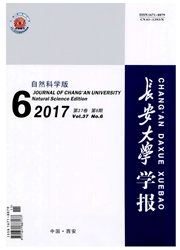

 中文摘要:
中文摘要:
为提高柴油机的燃烧热效率及有效降低有害排放物,在1台高压共轨单缸柴油机上,运用2段预喷和1段主喷组合的多段燃油喷射,并耦合高EGR率以实现低温预混合燃烧。在不同放热中心及EGR率的条件下,对比研究柴油及D10燃料(在柴油中掺入10%碳酸二甲酯)的排放性能。研究结果表明:随着放热中心(crank angle 50,CA50)后移,NOx排放显著降低,HC及CO排放的变化则相对平缓,PM排放呈先增加后降低的趋势;通过调整燃油喷射系统参数调控CA50(燃油路径)及采用EGR率(气体路径)均可实现对NOx的控制,但对其他排放物的作用效果却各不相同;高EGR氛围耦合较晚的CA50,即燃油路径与气体路径二者良好的匹配使用,可实现NOx和PM这2个目标变量的兼顾控制;与柴油相比,使用含氧燃料D10后,HC和CO均略有下降,NOx排放略有上升,但在PM排放方面可以获得大幅度的降低,可为NOx与PM排放之间的再平衡提供更大的空间。
 英文摘要:
英文摘要:
In order to improve the thermal efficiency of combustion of diesel engine and reduce harmful emissions effectively, the multiple injections consisted of two pilot injections and one main injection and hign EGR rate were coupled to realize the low-temperature premixed combustion on a single-cylinder common-rail diesel engine. Under different CA50 and EGR rates, the emissions features of diesel and D10 fuel (10% DMC and 90% diesel by volume) were studied. The results show that with the retarding of CA50, the NOx emissions are significantly reduced and HC and CO emissions vary relatively smooth, while PM emissions lastly increase and then dicrense. The NOx emissions can be regulated by the fuel injection parameters (fuel path) and EGR rate (air path), but different effects of each method are put on other emission matters. Later CA50 is coupled with high EGR, which means that the fuel path combined with the air path, can fulfill a favorable compromised control for both NOx and PM emissions. Compared with diesel, HC and CO emissions both decrease slightly after using D10 fuel, and NOx emissions increase appreciably, while the sharp reduction in PM emissions can be gained, which provides large space for the balance between NOx and PM emissions. 3 tabs, 5 figs, 17 refs.
 同期刊论文项目
同期刊论文项目
 同项目期刊论文
同项目期刊论文
 期刊信息
期刊信息
